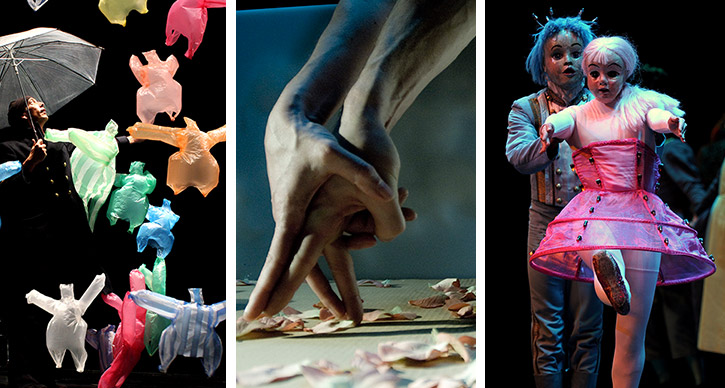Performing Objects: Beyond Puppetry

Examples of object performance abound in our 2014-2015 season. From left to right, Prelude to the Afternoon of a Foehn, Kiss & Cry, and Cinderella. Photos courtesy of the artists.
A plastic bag caught in the wind. Two hands intertwined in a miniature embrace. A doll-like mask covering a dancer’s face.
Each of these performing objects will make an appearance on a UMS stage this season.
But what exactly are “performing objects”? Are they puppets? Or something else?
In the 1980s, puppet scholar Frank Proschan defined “performing objects” as “material images of humans, animals or spirits that are created, displayed, or manipulated in narrative or dramatic performance.” By design, this is an exceedingly broad umbrella term; performing objects include but exceed traditional definitions of puppetry, which are themselves expanding. As scholar Claudia Orenstein describes it, “When we say ‘puppet’ we are no longer speaking exclusively of the figurative, crafted characters dangled from strings, gloved on hands, or attached to rods that the word had previously evoked: the Punch, Guignol, Howdy Doody, Lamb Chop, Kukla and Kermit characters of our childhoods.”
Performing objects multiply the physical, psychological and emotional possibilities of what can be done on stage. Objects have movement capacities that humans do not possess; though objects can be anthropomorphized and ascribed humanlike emotional qualities, they are often used to push the boundaries of what is acceptable or tasteful, in ways that would be more difficult for audiences to accept with a human performer.
Last season, UMS audiences saw three masterful performances of puppetry. The UK’s Blind Summit created both the series of life-size puppets representing the title character in Complicite’s Shun-kin and the pint-size Biblical imp Moses in The Table; though these puppets were very different in appearance and in the role they played in each production, all were created in the bunraku tradition from Japan, which utilizes three puppeteers to operate each puppet. Our audiences were also able to see the work of another modern puppet innovator, South Africa’s Handspring Puppet Company, in our National Theatre Live broadcast of War Horse. Their massive, startlingly beautiful and emotionally resonant horse puppets for that piece are critical to the impact of that World War I tale, which has played to great acclaim worldwide.
This season builds on those experiences and provides several rich examples of “performing objects” in Kiss & Cry, Prelude to the Afternoon of a Foehn, and Cinderella, where objects take on a degree of humanity, and human bodies and body parts are rendered as objects.
Behind the scenes with Kiss & Cry:
In Kiss & Cry hands, anatomized in close-up on projected film images, stand in for the whole person; the work’s dramatization of romantic entanglements takes on a level of revelatory strangeness while still maintaining the intimacy of genuine human contact. In Lyon Opera Ballet’s Cinderella, the traditional romance of the fairy tale and Prokofiev’s score are undercut and made humorous by the prominent use of toys on stage. Additionally, the dancers themselves are depicted as toys: faces covered in doll-like masks, they also move with the articulated stiffness of dolls.
A selection from the performance of Prelude to the Afternoon of a Foehn:
In Prelude to the Afternoon of a Foehn, everyday plastic shopping bags dance their own kind of ballet, manipulated by a single human performer and a series of electric fans. Tied to mimic the human form, reminiscent of balloon animals in a variety of bold colors, the bags beautifully illustrate Debussy’s score and complicate our notions of these objects as trash.
Performing objects mimic, illuminate, and make strange both the human form and human experience. Using a variety of materials, from the elevated to the everyday, the artists creating these works invite us to see the world in new and marvelous ways.
Have questions for Shannon? Ask them in the comments below.






